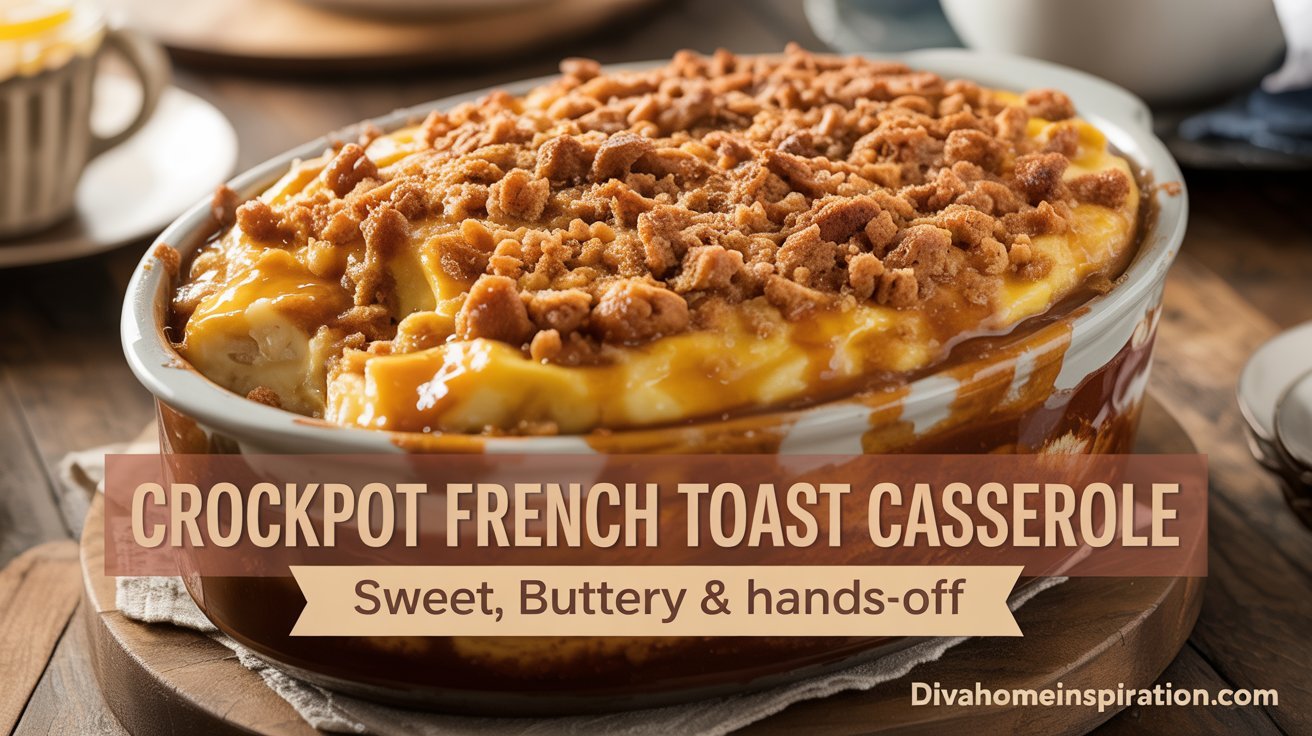This article may contain affiliate links. If you click on these links and make a purchase, we may receive a small commission at no extra cost to you. This helps support our website and allows us to continue to produce content like this. Thank you for your support!
If you’re looking to add a touch of nature to your home, growing fruit trees indoors is a fun and rewarding option. Not only do they provide fresh fruit, but they also brighten up your space and improve air quality. When choosing the right trees, consider varieties like dwarf citrus, figs, or even tropical fruits that thrive in pots. Remember to give them plenty of sunlight, keep the soil well-drained, and water them appropriately to keep them healthy and fruitful.
Sweet Pepper Tree
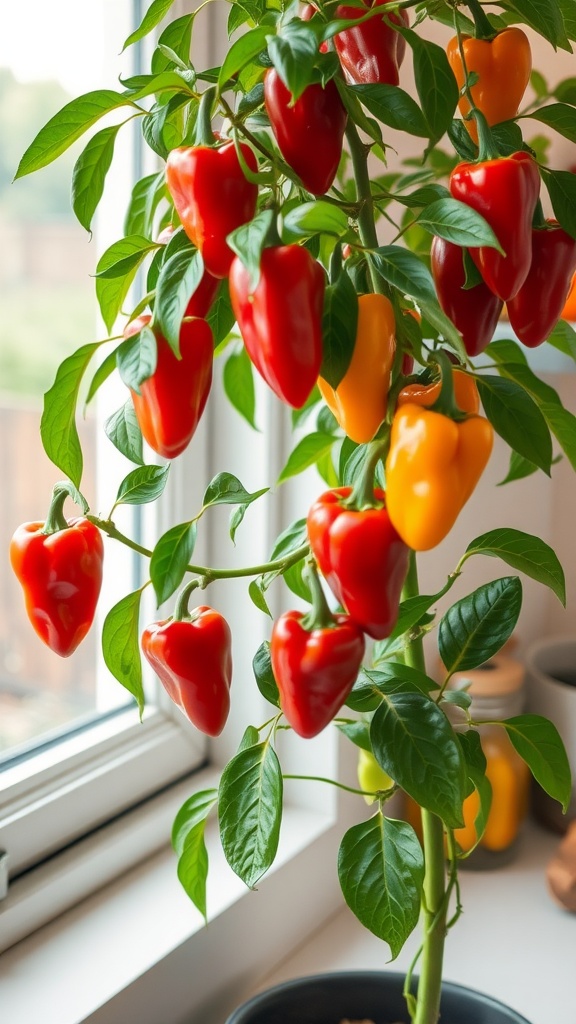
The sweet pepper tree is a delightful addition to any indoor garden. With its vibrant red and yellow peppers hanging from lush green leaves, this plant not only looks beautiful but also provides fresh produce right from your home.
Growing a sweet pepper tree in a container is quite simple. Ensure your pot has good drainage and use a quality potting mix. Place the tree near a sunny window, as it thrives in bright light. If you want to create an indoor food garden, this is a fantastic choice.
Indoor tree care for your sweet pepper plant is essential for healthy growth. Water it thoroughly, but let the top inch of soil dry out between watering. This helps prevent root rot. Fertilize with a balanced fertilizer every few weeks to keep it nourished.
In terms of pests, keep an eye out for aphids or spider mites. If you spot them, a gentle wash with water or a neem oil spray can help. Lastly, enjoy the process of growing fruits you can grow indoors, as it adds joy and flavor to your meals!
Dwarf Banana Plant
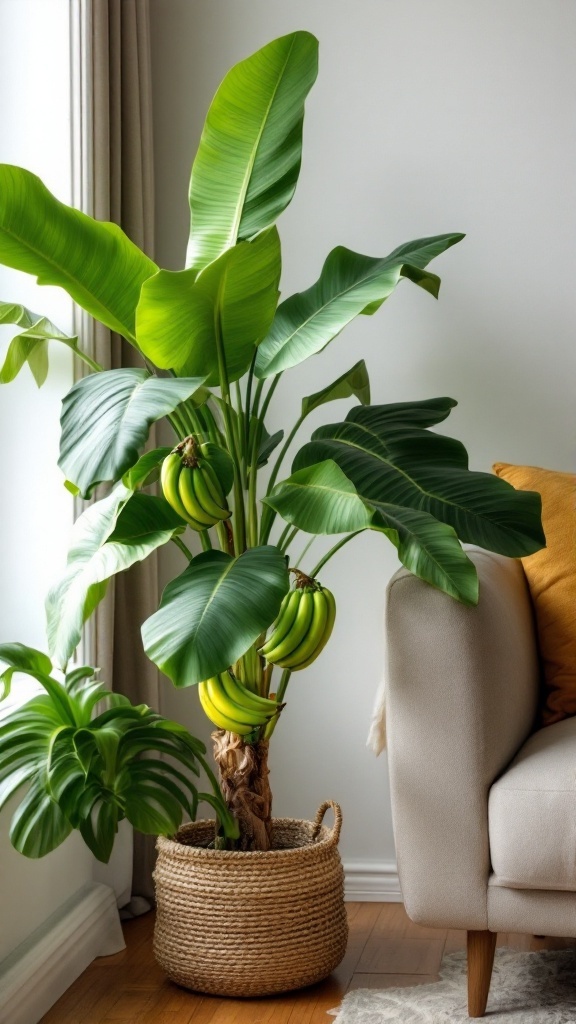
If you’re looking for a fun and unique addition to your indoor garden, a dwarf banana plant might just be the ticket! These charming little trees can thrive in pots and even produce fruit indoors. With their large, lush leaves and cheerful yellow bananas, they can brighten up any space.
When caring for your dwarf banana plant, it’s essential to give it plenty of sunlight. Place it near a window where it can soak up bright, indirect light for several hours a day. This will help the plant grow strong and healthy.
Watering is crucial too. Make sure to keep the soil moist but not soggy. Overwatering can lead to root rot, so check the top inch of soil before deciding to water again. Fertilizing is also important; use a balanced fertilizer every month during the growing season for best results.
As for temperature, banana plants enjoy warmth. Aim for temperatures between 70°F to 90°F. If your space is cooler, try to place the plant in a warmer spot, as it may not thrive in chilly conditions.
Lastly, don’t forget to prune your plant. Removing any dead or yellowing leaves will encourage new growth and make your indoor fruit garden look tidy. With a little care, your dwarf banana plant can not only grow well but also provide you with delightful fruits to enjoy!
Calamondin Orange Tree
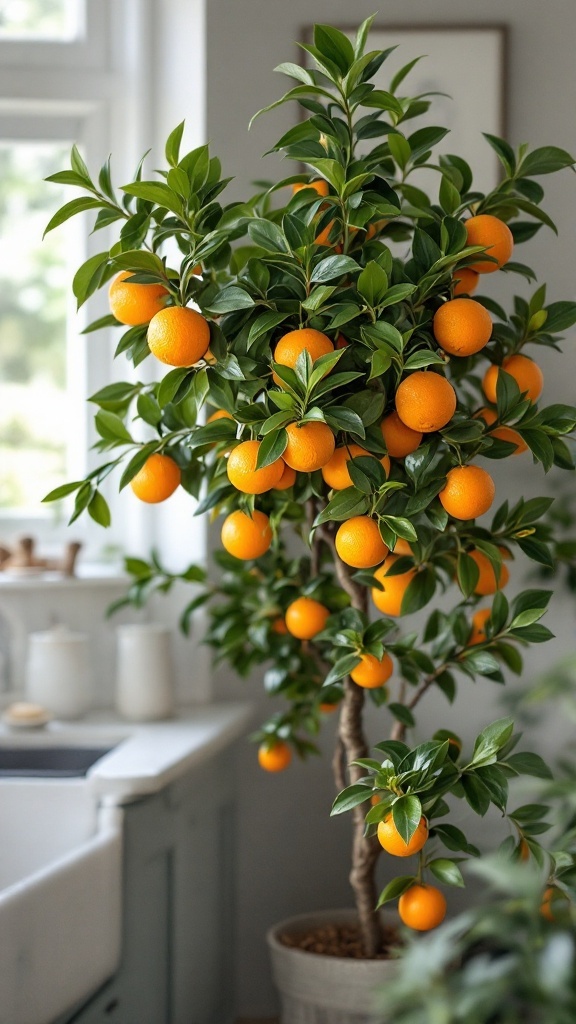
The Calamondin orange tree is a delightful choice for indoor gardening. With its vibrant oranges and glossy green leaves, it brings a burst of color to any space. This small tree is perfect for growing indoors, making it a popular option for those looking to cultivate fruit in containers.
These trees thrive in pots, which means you can easily move them around to catch the sun or relocate them if needed. One of the appealing aspects of growing a calamondin is that the fruits are not only beautiful but also edible. You can use them in various recipes, from marinades to desserts, adding a zesty flavor to your dishes.
To care for your calamondin orange tree, it’s essential to provide the right light and watering conditions. Place it in a sunny spot where it can soak up at least 8 hours of light each day. When it comes to watering, let the top inch of soil dry out before giving it a drink. This will help prevent overwatering, which can lead to root rot.
Another vital aspect of indoor tree care is feeding. Use a balanced fertilizer during the growing season to encourage fruit production. Also, make sure to prune the tree regularly to promote healthy growth and maintain its shape. These simple tips will help you enjoy indoor fruit plants that not only look good but also provide fresh fruits for your kitchen.
Indoor Pomegranate Tree
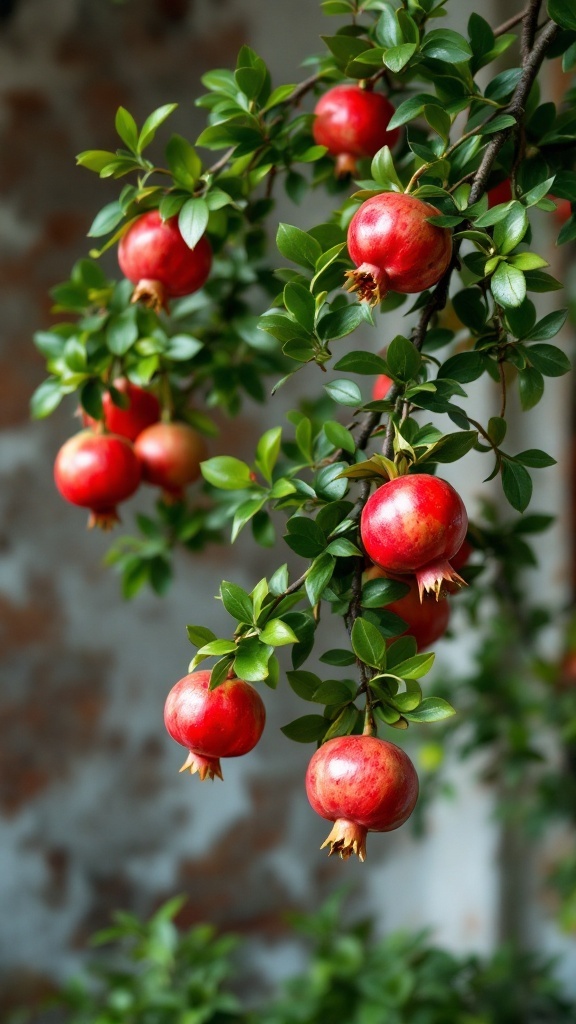
Growing an indoor pomegranate tree can be a rewarding experience. This vibrant tree, adorned with lush green leaves and bright red fruits, adds a touch of nature to your home. The sight of these beautiful, round pomegranates hanging from the branches is both delightful and motivating.
Pomegranates thrive in pots, making them an excellent choice for an indoor food garden. When thinking about fruit trees in pots, you’ll find that pomegranates are not just easy to grow but also a joy to care for. They require plenty of sunlight, so place your tree near a bright window where it can soak up those rays.
For the health of your pomegranate, regular watering is key. Ensure the pot has good drainage to prevent any waterlogging. You want the soil to be moist but not soggy. Fertilizing during the growing season will give your tree the nutrients it needs to produce those lovely fruits.
As the tree grows, you may need to prune it to encourage better airflow and fruit production. Don’t forget to keep an eye out for pests. A quick wash with water can help keep your tree healthy and thriving.
Pomegranates can adapt to indoor conditions, making them perfect fruits to grow indoors. With a little patience and care, you’ll be rewarded with fresh pomegranates right from your home. Enjoy this delightful addition to your indoor fruit plants!
Strawberry Vertically Grown
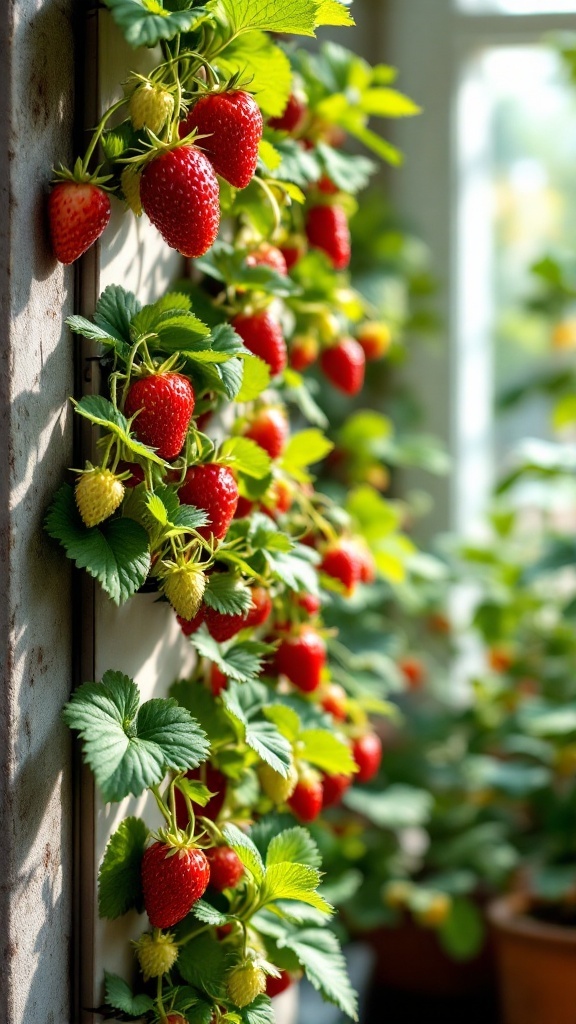
Growing strawberries vertically is a fun and efficient way to enjoy these sweet fruits indoors. This method not only saves space but also makes it easier to care for your plants. Imagine fresh strawberries right at your fingertips!
When growing strawberries in containers, ensure you choose the right variety suited for indoor conditions. Look for everbearing or day-neutral types, as they produce fruit throughout the growing season. Using vertical planters or wall-mounted systems can maximize sunlight exposure and air circulation, which are key for healthy plants.
Indoor fruit garden ideas can include mixing strawberries with herbs or flowers to create a lively display. Make sure your vertical garden gets plenty of light, ideally 6-8 hours a day. If natural light is scarce, consider using grow lights to keep your plants thriving.
For easy-to-grow fruits indoors, strawberries are a great choice. They not only yield delicious fruits but also add greenery to your space. Water your plants consistently, keeping the soil moist but not soggy. A good rule of thumb is to water when the top inch of soil feels dry.
When it comes to indoor tree care, regularly checking for pests and diseases is essential. Remove any dead or yellowing leaves to promote better growth. Fertilizing every few weeks with a balanced fertilizer will also help your strawberries flourish.
Potted Olive Tree
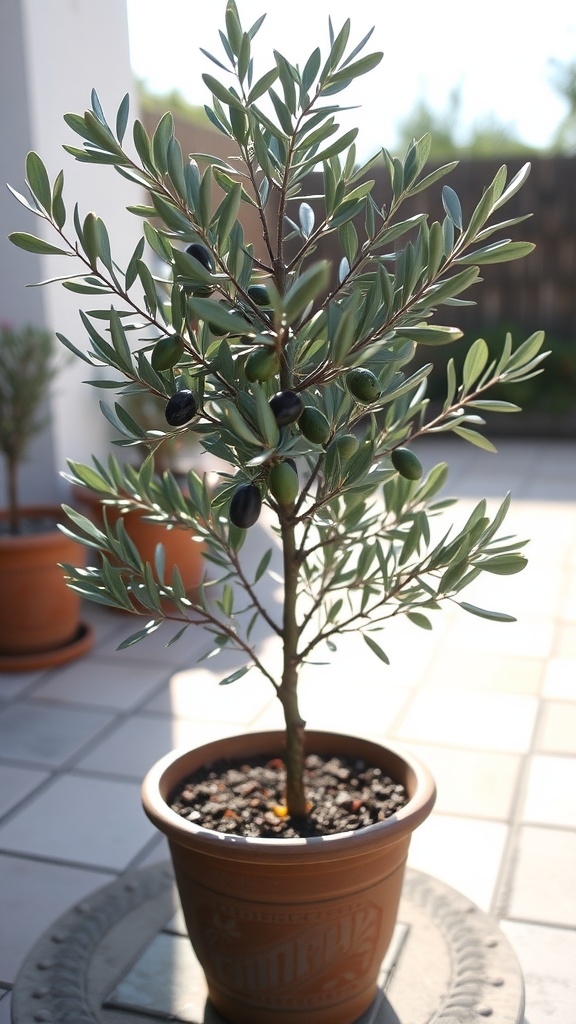
Growing a potted olive tree is a delightful way to introduce a touch of the Mediterranean to your indoor space. With its slender trunk and lush green leaves, the olive tree is not just a beautiful addition; it also produces small, tasty olives. These trees are well-suited for containers, making them a great option for anyone looking to grow fruits indoors.
When you choose to grow an olive tree in a pot, make sure to select a container with good drainage. This is crucial since olive trees prefer dry conditions. A pot that is about 12 to 16 inches deep will provide enough room for the roots to expand. Use a well-draining potting mix to keep your tree healthy.
Position your potted olive tree in a spot that gets plenty of sunlight. Ideally, it needs about 6 hours of direct sunlight each day. If your indoor space lacks natural light, consider using grow lights to assist with light needs.
Watering is another important aspect of care. Allow the soil to dry out between waterings. Overwatering can lead to root rot, which is a common issue for indoor fruit plants. During the growing season, a balanced fertilizer can help boost growth and fruit production.
Keep an eye out for pests like aphids or spider mites. Regularly checking your plant and cleaning the leaves can help prevent infestations. An indoor fruit garden can be a fun project, and growing an olive tree is a rewarding experience that adds greenery and flavor to your home.
Dwarf Meyer Lemon Tree
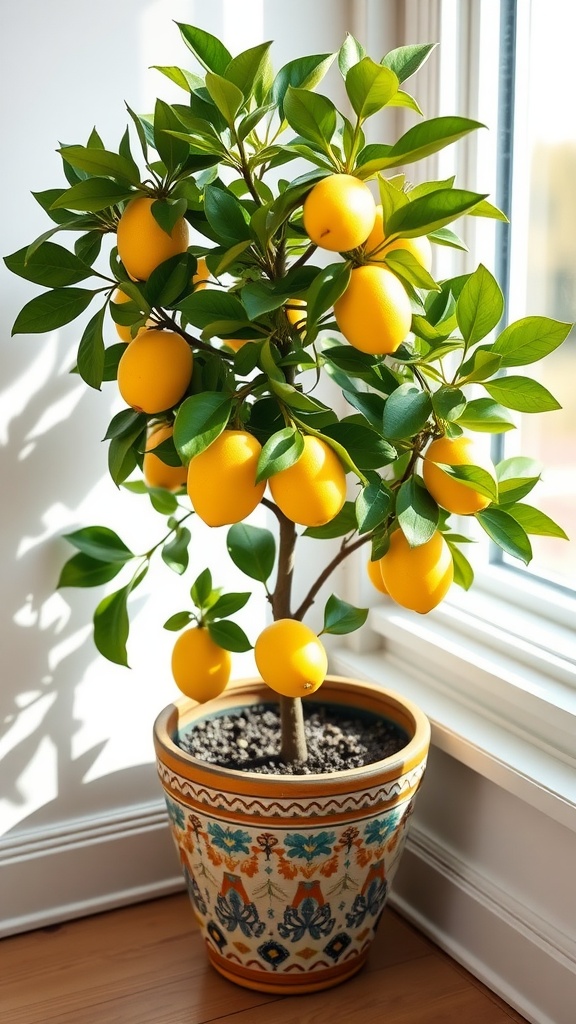
The Dwarf Meyer Lemon Tree is a delightful choice for indoor gardening. Its compact size makes it perfect for growing in a pot on your windowsill. This tree not only produces vibrant yellow lemons but also adds a splash of greenery to your space.
To give this tree the best chance to thrive, place it in a bright spot where it can soak up plenty of sunlight. Aim for at least 10-12 hours of light daily. You’ll want to rotate the pot occasionally so all sides of the tree get adequate sun exposure.
Watering is crucial. Let the top inch of soil dry out before watering again. Overwatering can lead to root rot, so be sure to use a well-draining potting mix. Fertilizing every month during the growing season will help nourish your indoor fruit plants and encourage healthy growth.
With proper care, your Meyer Lemon Tree will reward you with fragrant blossoms and delicious fruit. It’s one of the easy-to-grow fruits that can transform your indoor food garden into a joyful experience. Not only do you get fresh lemons, but you also enjoy the beauty of the tree throughout the year.
Miniature Fig Tree
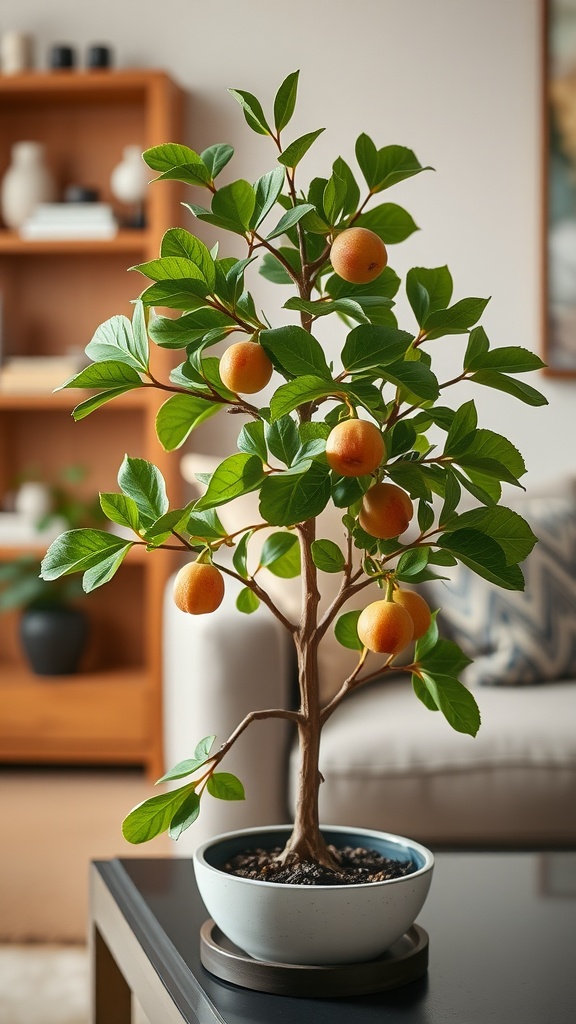
Miniature fig trees can be a delightful addition to your indoor space. These charming little trees are not only pleasing to the eye but also produce sweet, delicious figs. While they thrive outdoors, growing them indoors is entirely possible with a few tips.
When choosing a pot, make sure it has good drainage. A container that is around 12-16 inches wide will give your fig tree enough room to grow. Use a well-draining potting mix to keep the roots healthy and prevent rot.
Place your fig tree in a bright location. These trees love sunlight, so a south-facing window is ideal. If you notice the leaves starting to drop, it may be a sign that it’s not getting enough light.
Watering is crucial for indoor fruit plants, but be careful not to overwater. Allow the top inch of soil to dry out before watering again. During the growing season, which is typically spring and summer, you might need to water more frequently.
Fertilizing your miniature fig tree every few weeks during the growing season can help it thrive. A balanced, water-soluble fertilizer works well. Just follow the instructions on the label to avoid over-fertilizing.
Pruning can also be beneficial. Trim back any dead or overgrown branches to encourage healthy growth. This not only keeps the tree looking nice but also helps with air circulation.
With the right care, your indoor fruit garden can flourish. Miniature fig trees are among the fruits you can grow indoors, adding both beauty and deliciousness to your home.
Navel Orange Tree
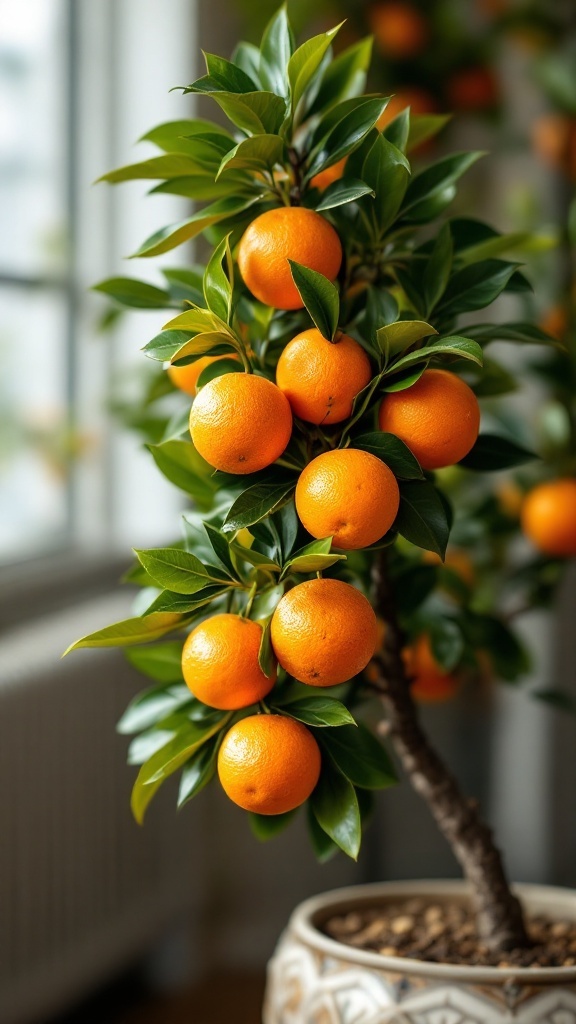
Growing a Navel Orange tree indoors can be a delightful experience. These trees not only produce sweet, juicy oranges but also add a vibrant touch of greenery to your home. The image showcases a lovely Navel Orange tree in a pot, filled with bright oranges and lush green leaves. It’s a perfect example of how fruit plants can thrive indoors.
To get started, choose a pot that allows for good drainage. Use a well-draining potting mix to help your tree thrive. Navel Orange trees prefer bright, indirect sunlight, so it’s important to place them near a window that gets plenty of light. If you notice your tree stretching toward the light, it may need more sun exposure.
Watering is another key aspect of indoor fruit plants care. Make sure the soil is moderately moist but not soggy. Allow the top inch of the soil to dry out before watering again. This helps prevent root rot, which can be a problem for container plants. Additionally, feeding your Navel Orange tree with a balanced fertilizer during the growing season will support healthy fruit production.
As with any indoor food garden ideas, keep an eye out for common pests like aphids or spider mites. If you notice any, gently wash them off with a mixture of water and mild soap.
In summary, growing a Navel Orange tree indoors is not just possible; it’s rewarding. With proper care, including adequate sunlight, appropriate watering, and regular feeding, you can enjoy healthy fruits right from your indoor fruit plants.
Indoor Cherry Tree
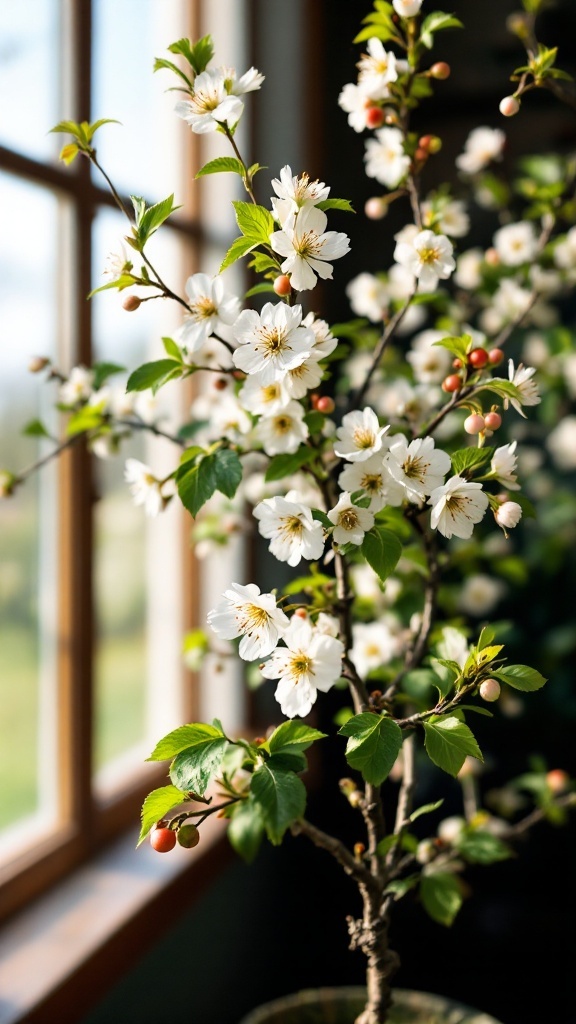
Indoor cherry trees are a delightful addition to any home. They bring a burst of color with their beautiful white blossoms and vibrant red fruits. Plus, they can be grown in pots, making them a great choice for indoor spaces.
If you’re wondering about the fruits you can grow indoors, cherry trees stand out as a charming option. They can thrive inside with the right care, and the sight of those lovely flowers turning into cherries is quite rewarding.
When growing a fruit tree in a container, it’s essential to choose the right pot. A deep container helps ensure the roots have enough space to grow. Make sure to use well-draining soil to keep the tree healthy.
Indoor cherry trees need plenty of sunlight. Ideally, place them near a sunny window where they can soak up at least six hours of light each day. This will help them produce those lovely flowers and fruits.
Watering is another crucial aspect. Keep the soil moist but not soggy. It’s best to check the moisture level regularly. If the top inch of soil feels dry, it’s time to give your tree a drink.
Regular pruning helps maintain a good shape and encourages fruit production. You can trim back any dead or overgrown branches, promoting healthier growth.
In terms of nutrition, fertilizing your indoor fruit plants during the growing season will support their growth. A balanced fertilizer will work wonders.
With the right care, your indoor cherry tree can flourish, bringing both beauty and a touch of nature to your home. Enjoy the journey of growing fruits indoors!
Lime Tree in a Pot
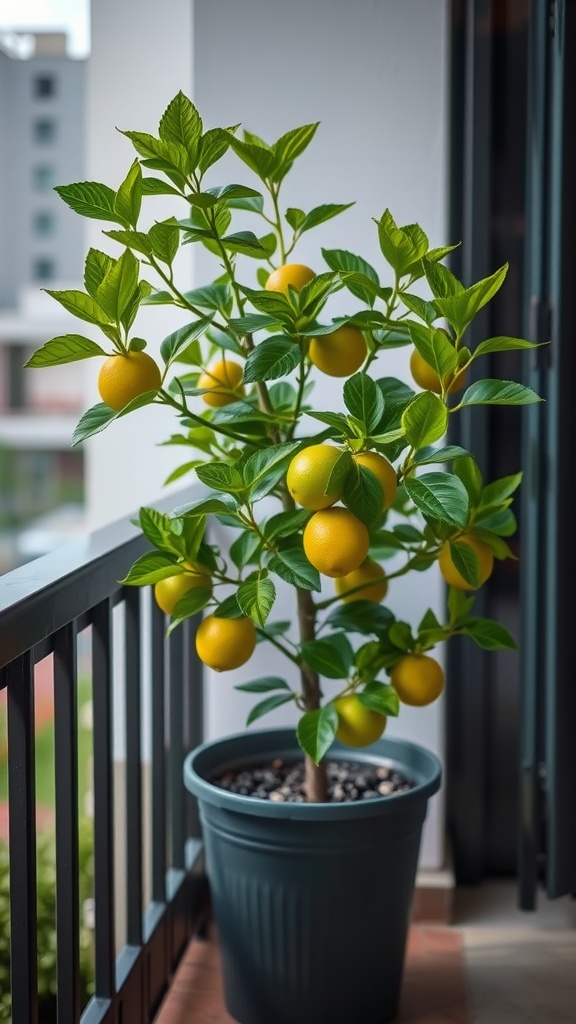
Imagine having a vibrant lime tree right in your living space. This delightful fruit tree in a container not only brightens up your home but also provides the joy of homegrown limes. Lime trees are relatively easy to grow indoors, making them a popular choice for indoor gardeners.
To successfully grow lime trees in pots, start with a well-draining potting mix and choose a container that allows for good root growth. Make sure your plant gets plenty of sunlight, ideally at least 10-12 hours a day. If you notice the leaves turning yellow, it could be a sign of overwatering or lack of nutrients.
Indoor tree care tips are crucial for keeping your lime tree healthy. Regularly check for pests and diseases. You can also give your tree a boost with a balanced fertilizer during the growing season. Keep the soil slightly moist, but avoid letting it sit in water.
Lime trees are not just functional; they can also serve as beautiful decor for your indoor food garden ideas. With the right care, you’ll be rewarded with fresh limes that can enhance your cooking and cocktails. Just imagine freshly squeezed lime juice from your very own tree!
Tropical Pineapple Plant

The tropical pineapple plant is a delightful addition to any indoor garden. Not only does it bring a touch of the tropics into your home, but it also showcases a stunning fruit that can be homegrown with some patience. This plant features long, arching leaves that create a lush, vibrant look, making it a favorite among indoor fruit plants.
Growing a pineapple indoors is quite simple. Start by choosing a healthy pineapple from the store, then cut off the leafy top. Let it dry for a few days to prevent rot, and then plant it in a container with well-draining soil. Place it in a sunny spot, as pineapple plants thrive in bright light. Water it regularly, but ensure the soil dries out between watering to avoid overwatering.
To encourage healthy growth, keep your indoor pineapple in a warm environment, ideally between 65°F and 95°F. Fertilizing every couple of months with a balanced fertilizer will help boost the plant’s growth and fruit production. If you’re looking for indoor food garden ideas, a pineapple plant is not only beautiful but also rewarding, as it eventually produces sweet, homegrown fruit you can enjoy.
When it comes to caring for your pineapple plant, remember to check for pests regularly. Common pests like mealybugs can be managed with insecticidal soap. A little attention goes a long way in maintaining this unique fruit tree in container. With the right care, your pineapple plant can become a lovely centerpiece in your home, reminding you of sunny days even in the colder months.


